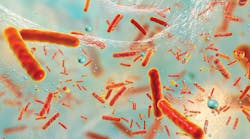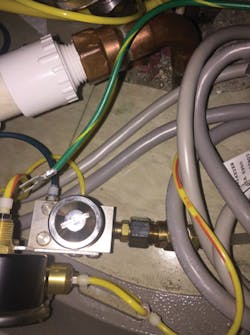A practical guide for testing dental unit waterlines: Part 2
Part one of this series discussed the science of dental unit waterline systems (DUWS), agencies thatoversee DUWS, and resources to help with compliance. Here, in part two, we discuss a case study in waterline testing and the keys to maintenance.
How do you know if the water is safe to use? Much like the need to monitor the effectiveness of your sterilizer, in order to know if your DUWS is safe, you must test the water. Microorganism count is not something you see with the naked eye. Testing must be done with a reliable company that can give you results quickly.
The case study
The Cabrillo College dental hygiene program conducted a research project on the need to monitor DUWS and have a reliable source for testing. This research was a great opportunity to learn about water testing and correct any possible issues. Many offices hesitate because they are unsure of what to do if they fail the test. Having reliable resources in place ahead of time proved to be vital in resuming clinic as quickly as possible.
Related reading
Dental unit waterlines: Trickier than you think
The product chosen for testing was the mail-in waterline kit from ProEdge Dental Water Labs. These kits provide a third-party laboratory testing service and expert consultation. This lab’s testing methods meet the gold standard for waterline monitoring as suggested in a number of dental studies and by the Organization for Safety, Asepsis and Prevention (OSAP). For example, the company uses a neutralizer for any disinfectant that may be present in the sample, allowing for more accurate bacteria counts. Antimicrobials in the water sample, which remain present unless neutralized, can inhibit the growth of viable bacteria during incubation.
ProEdge’s employees are trained and working under controlled conditions with the most updated equipment available. Serial plating is used with a low-nutrient R2A agar. All counting is done through a state-of-the-art digital system. This is one of the few companies that has been validated by a third party.
The testing was conducted just prior to a long period of clinic downtime at Cabrillo College. The process students followed was determined by instruction that accompanied the sterile testing kits.
Figure 1: A redundant filter discovered during the college’s troubleshooting. Removal of the filter and treatment of the lines resolved all issues.
Testing and outcome
Sixteen students collected samples, while four students monitored for compliance with directions and cross-contamination breaches. Two additional students recorded activity and prepared samples for mailing following instructions for use (IFU), which included cold packing and overnight delivery to ProEdge.
Test 1: The dental units were tested “as is,” with no cleaning or shocking. All units failed—with a majority being too numerous to count (TNTC). The dental unit manufacturer was consulted for IFU, as well as the manufacturer of the testing kit (ProEdge).
Test 2: The in-line filters on all units were replaced, and the lines were shocked with a hydrogen peroxide–based product following the IFU. The lines were retested, and all of the units failed, with the majority being TNTC.
Test 3: The whole system was investigated, including the city water coming into the building, the filter system on the building, the delivery bottle, and the tubing. Consultation was done with the manufacturer of the shocking agent and the testing kit to make sure protocols were being followed properly. The unit was taken apart to check for kinks in the line. An extra filter was found (figure 1). These filters were replaced, and the system was shocked with the hydrogen peroxide–based product again. All units were tested and passed at below 200 CFU (colony-forming units)/mL.
Discussion
This situation will certainly not be applicable to every practice, but it illustrates the potential complexity of waterline maintenance and the necessity of quality testing to reveal current water safety and assist in discovering problem areas.
This study also revealed the importance of adherence to instructions for care of waterlines and IFU for dental devices and disinfectants. Most issues involved in the process are simple to resolve.
After investigation of all dental units following the two test failures, we wondered if the product used for shocking the lines or the in-line filter was effective in bringing the CFU count down. The third results confirmed the products were not at fault. Both of these products had Environmental Protection Agency (EPA) approval and rigorous testing for effectiveness. It was important to look at the entire process before abandoning an EPA-approved product or processes.
How do we achieve compliance?
For most dental offices, it will be very simple to pass the test. The basics, or ABCs, of water protocols see the best waterline safety results. In an interview, ProEdge Dental Water Labs reported that after conducting more than 150,000 tests, they have found that the vast majority of offices that learn to effectively implement these ABCs see the best waterline safety results. The ABCs are: A. shocking; B. treating; and C. testing.
Consult with the dental unit manufacturer for appropriate methods, products, and equipment to maintain the quality of water in your unit. Commercial devices and procedures designed for this purpose include self-contained water systems (i.e., independent water reservoir) combined with chemical treatment (i.e., periodic or continuous chemical germicide treatment protocols);systems designed for single-unit or entire-practice waterlines that purify or treat incoming water to remove or inactivate microorganisms; orcombinations of these methods.
Each of these methods requires adherence and understanding of their use. Following the IFU of antimicrobial chemicals and technology will help control the likelihood of bad testing results. Periodic shocking of dental lines is also part of the process and should be part of your monthly routine.
The Food and Drug Administration states, “Dental practitioners should adopt appropriate infection control procedures for dental unit waterlines based on the manufacturer’s instructions for use (IFU). This should include infection control measures such as, but not limited to, monitoring water quality. The water management plan should include specific testing locations and frequencies, and actions to take (e.g., remediation, retesting at shorter intervals) based on test results.”1 This process should also include staff training, which will assure the entire office is following IFU and is competent.
If your office does not have the IFU for their DUWS, call the manufacturer of the device and ask them to email you a copy or direct you to it online. Do not just get the directions from a salesperson verbally. These directions need to be readily available to for reference and staff training.
Along with other standard infection control procedures, waterlines need a written protocol for quality assurance. This can be best accomplished with a checklist. The list should include use of the equipment, use of filtration system, changing of bottles, and other treatment protocols. OSAP supplies a solid checklist at osap.org/page/issues_DUWL.
Here are a few things to include as you develop your protocol that can help prevent biofilm formation and bacterial proliferation, based on a 2018 FDA publication:
1. Purge (i.e., remove water from) the waterlines each night and whenever units are out of service to prevent stagnation. Know the simple method for purging your unit. This is necessary with specific units and types of treatment.
2. Discharge water and air lines for a minimum of two minutes at the start of the day and 20–30 seconds after each patient to physically flush out patient material that might have entered the DUWS during treatment.
3. Check water as it discharges for signs of contamination: musty odor, cloudiness, particulates, and clogging of lines.
4. Monitor waterlines for damage or visible contamination and replace if needed or as directed by the manufacturer. Check for kinked lines where water cannot flow properly.
5. Follow the manufacturer’s instructions to clean and disinfect the unit at >recommended intervals with the recommended products. Contact the manufacturer to obtain the most up-to-date instructions or with any questions regarding the reprocessing.
6. Shock the line monthly or as directed by the manufacturer or as needed from testing results. It is important to remove all shocking chemicals before treating patients. Shocking chemicals should not be confused with daily or continuous treatment products, which include some that are safe for patient care.
7. Monitor the water quality and microbial contamination of DUWS using standard culturing methods at appropriate intervals.1
When should we test?
The purpose of testing is to validate your processes. Before your first test, it is recommended that you shock the line and replace cartridges and do daily treatment as recommended. This will allow you to see if your process is effective and learn to detect any missing procedures.
The CDC does not give a guideline on testing frequency. Once you pass your test, manufacturers recommended that the lines be tested at least quarterly. If you fail a test, you should investigate, resolve the issue, and retest for quality until the issues are all resolved and your CFU are within the limits set by the IFU. Monthly testing should occur until you have good compliance results consecutively. You can then start to test quarterly. Allowing the testing to wait can create an issue that is harder to resolve. The higher the CFU, the more difficult it is to resolve the issues.
Author’s note: Next article, we’ll discuss how to handle a testing failure in more detail. A special thanks to the class of 2018 and Cabrillo College for their dedication to this research project: Amanda Anfield, Stephanie Archibald, Sarah Augenstein, Maria Becerra, Jessica Carrera, Kristan Castro, Daniel Donoghue, Jordan Durrer, Adriana Garza, Esther Gonzales, Amanda Mason, Sara Nelson, Thomas Nop, Annalisa Ortiz, Sierra Partridge, Michelle Peterson, Thi Phan, Kathlyn Romero, Halley Santaella, Katia Serrano, Lorena Thomas, and Michelle Van Schoick.
Updated November 29, 2022
Reference
1. Dental Unit Waterlines. US Food and Drug Administration website. https://www.fda.gov/medicaldevices/productsandmedicalprocedures/dentalproducts/ucm610545.htm. Updated September 4, 2018.







